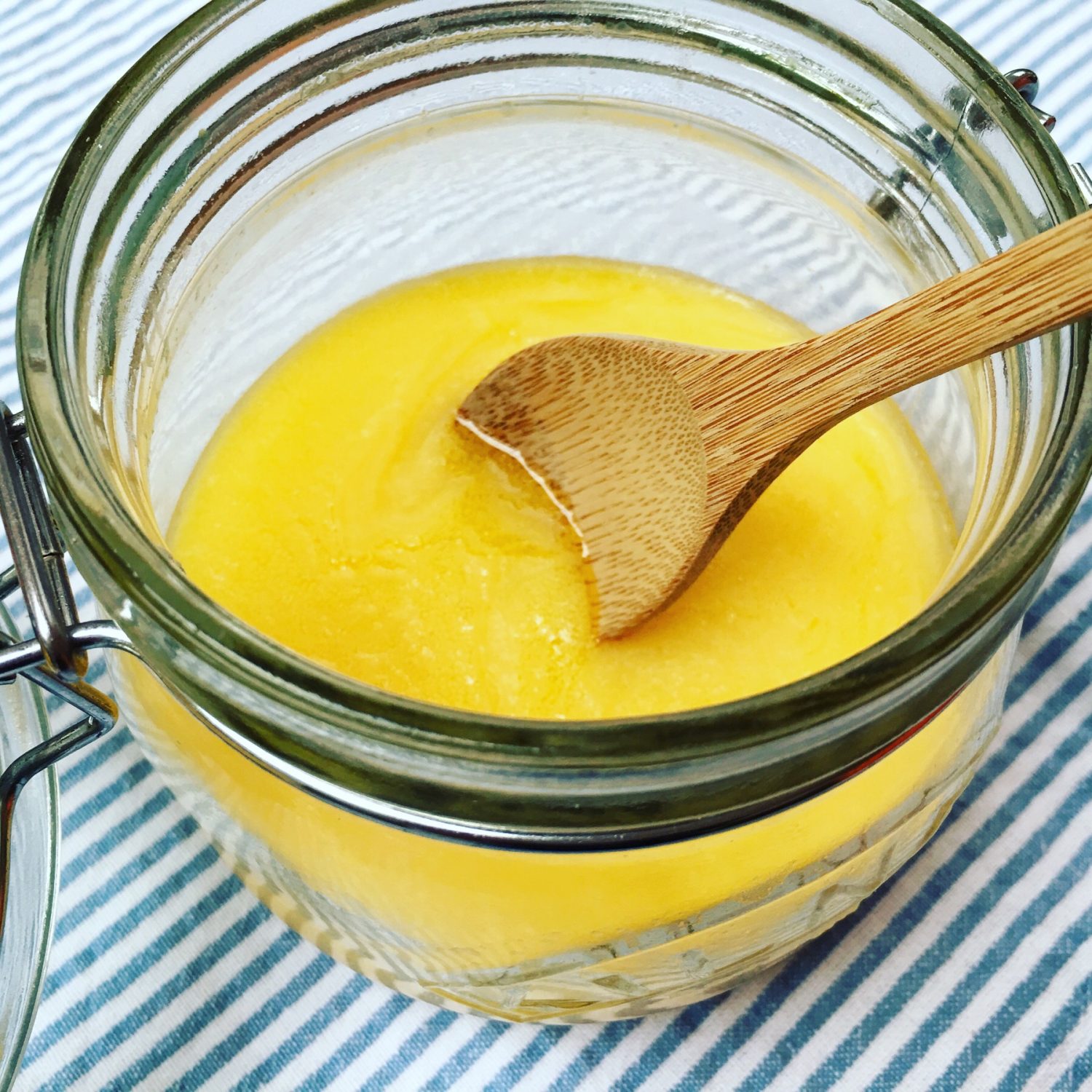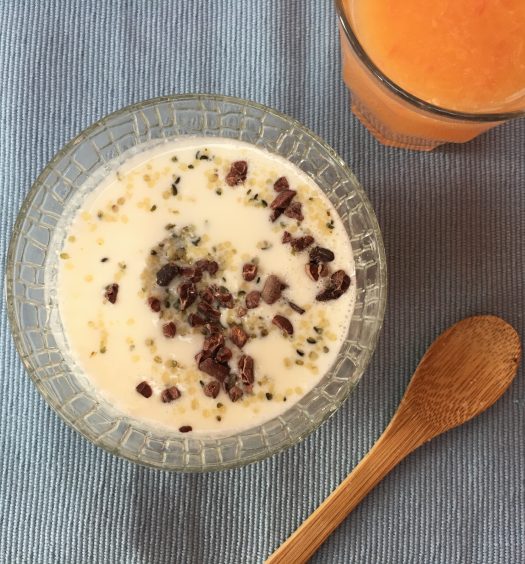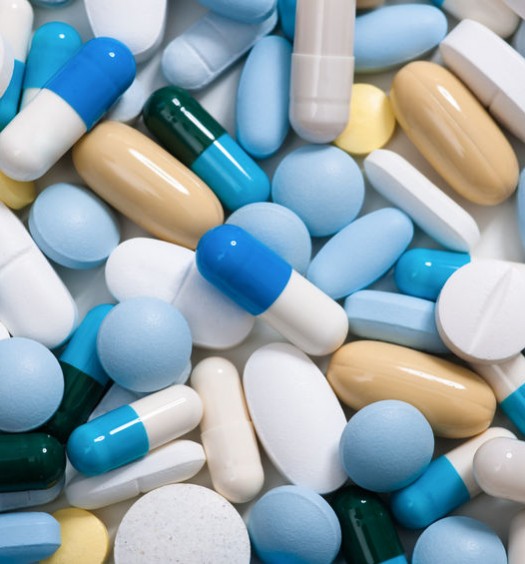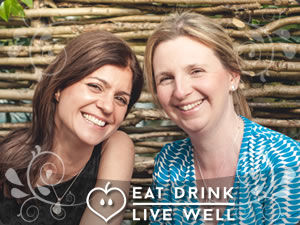An easy recipe for homemade ghee
Ghee (also known as clarified butter), has been around for thousands of years; it’s one of the most nourishing foods around and is one of the best fats to cook with. As the milk solids are removed it’s lactose and casein free, meaning those who are lactose intolerant or casein sensitive should also be able to enjoy ghee. Homemade ghee is also unbelievably easy to make and tastes amazing; I really can’t imagine my kitchen without it now that I’ve started making it on a regular basis.
I’d dabbled with ghee a bit in the past, buying a tin of it that to be honest sat at the back of the fridge for most of it’s life, emerging for the odd home-made curry and then returning to it’s cold home. That really was the total extent of my relationship with ghee, despite regularly recommending it to clients as an alternative, beneficial cooking oil.
Earlier this year I was looking at ways to support digestive health, specifically raising Short Chain Fatty Acids in the gut and ghee cropped up again – so I decided it really warranted a little more attention than thus far it had received from me.
Short Chain Fatty Acids (SCFAs), particularly butyric acid (butyrate), are helpful to our gut by acting as fuel for the epithelial cells – the cells that line the digestive tract. In essence, SCFAs promote a healthy gut lining, helping to reduce the risk of intestinal permeability (‘leaky’ gut) and thus food allergies and sensitivities. SCFAs quite simply nourish the cells that we now know are so important for so much more than ‘just’ absorbing nutrients from the foods that we eat. We know that inadequate levels of SCFAs are associated with disrupted gut health and that butyrate itself is anti-inflammatory; research indicates that adequate levels of SCFAs may be helpful for those suffering with IBS, Crohns and Ulcerative Colitis, as well as potentially supporting healthy levels of insulin.
We often test for SCFA levels in our clinic, and frequently test results come back with a ‘low’ result. This may be due to a low plant food intake, or ‘dysbiosis’ in the gut (an imbalance in the microflora): the bacteria that produce SCFAs may just not be there in high enough levels.
The easiest way to boost SCFAs is to raise the amount of plant foods in the diet, so that the anaerobic bacteria in the gut can feed off the fibre and/or resistant starch, producing SCFAs as a result.
However – and this is where it can get complicated – some of the digestive supportive eating plans we put our clients on (e.g. Low FODMAP, SIBO) may include, on a temporary basis, a reduction in fibre in order to alleviate immediate digestive symptoms while we work on the root cause. This reduces the foods that can actually help to raise the SCFAs – so it’s a bit of a Catch 22 situation: whether to boost the fibre to raise SCFAs at the risk of worsening GI symptoms in some people, or whether to ignore SCFAs for the moment, and sort it out later.
Well it turns out that ghee is a great source of the SCFA butyrate; it’s a low fibre way of helping to boost the important SCFAs, so is now regularly included in most of our digestive supportive protocols – especially now we realise how massively simple it is to make.
Health Benefits of Ghee
- A good source of butyric acid, supporting digestive health (see above)
- A good source of the retinol form of Vitamin A (great if like me you have a reduced genetic ability to being able to convert the plant form of Vitamin A, beta-carotene, into the retinol form that is so vital for us) and other fat soluble nutrients Vitamins E, D and K2
- Using great quality, pasture-fed organic butter super-charges your ghee with extra Omega 3 fats as well as healthy CLA (Conjugated Linoleic Acid)
- Lactose and casein-free – due to skimming and straining off the milk solids
- High smoke point and not easily oxidised – meaning it’s a great fat to use in high heat cooking (unlike easily oxidised vegetable oils)
Use ghee in recipes where you would otherwise use butter or olive oil, and for high heat cooking. My jar of ghee sits right next to the hob on a permanent basis and I use it in everything from scrambled eggs to popcorn (and also happily eat it right from the spoon!)
- Melt the butter slowly in a heavy, wide saucepan over a low heat. Don’t rush this step - slow is better!
- Once melted, raise the temperature to a gentle simmer. Your butter may crackle and spatter a bit – and can be stirred if you want (although is not necessary)
- At this point you’ll see some white foam appear on the top of the butter – you can skim this off as you go if you want to see what’s happening underneath, or alternatively skim in one go at the end. Your butter will separate into 3 layers: 1. the foam 2. clear, golden butter 3. milk solids at the bottom of the pan (this is often the last layer to form)
- Simmer the butter for between 10 and 20 minutes until it is beautifully golden and fragrant. By this point the milk solids may begin to brown at the bottom of the pan. Keep an eye on your ghee as there’s a fine line between the milk solids browning and giving the ghee a nutty flavour, and the milk solids just burning.
- When you’re happy with the look of your ghee skim any remaining foam from the top and then turn the butter off and leave it to cool for 5-10 minutes.
- Gently pour the golden ghee through a fine meshed sieve (ideally lined with a nut milk bag or cheesecloth) into a sterilised jar, leaving the milk solids in the pan (or sieve). Leave to cool before putting the lid on.
- As it doesn’t spoil easily, your ghee can stay on the counter top or be refrigerated if you prefer a harder consistency. Left out, your ghee should solidify into a gorgeously pale golden fat overnight.
We hope you enjoy this blog post, let us know your thoughts in the comments below or on social media – we’re on Twitter, Facebook, Instagram and Pinterest. And don’t forget to sign up to our newsletter to receive a monthly update of our recipes, nutrition tips and expert advice.





